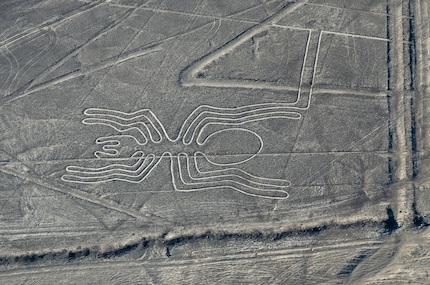
Cut-off heads and pets: AI helps to identify Nazca figures
A new study shows that an AI can be successful in analysing large amounts of data despite little training data. With its help, researchers discovered 303 previously unknown Nazca geoglyphs in Peru.
A research team led by Masato Sakai has used AI to identify 303 previously unknown Nazca geoglyphs in Peru in just six months. The researchers published their findings in September 2024 in the US journal "Proceedings of the National Academy of Sciences". The article is freely accessible.
A large proportion of the geoglyphs that have become known as a result show people, severed heads and domestic animals. Based on the results, the researchers are also trying to draw conclusions about the purpose of the Nazca figures.
What are Nazca geoglyphs?
In the period between around 100 BC and 650 AD, people from the Paracas and Nazca cultures created lines in the soil of the Peruvian Nazca Plain. They removed the top layer of rock to expose the lighter-coloured subsoil or used stones and gravel to mark the lines. Some lines run straight for up to 20 kilometres, others form figures - so-called geoglyphs, i.e. images in the landscape. They depict people, domestic and wild animals, plants and tools.
The known geoglyphs measure less than ten to several hundred metres in diameter. Due to their size, the shape of the figures can only be recognised from a distance, for example from the nearby paths that were used by people.

Source: Shutterstock/Schmidt Photography
In the 1940s, the search for new geoglyphs began with the help of aerial photographs. Since 2004, satellite images have also been used for this purpose. By 2020, 430 figures were known, 380 of them with a comparatively small average size of nine metres. They are spread over an area around 38 kilometres long and more than 20 kilometres wide.
How has AI helped with research
Despite the advantages of aerial archaeology, the search for new Nazca geoglyphs is difficult. The area in question is very large and the figures are often barely visible to the eye due to centuries of erosion. However, an AI can be trained to recognise patterns and is able to analyse data much faster than humans.
The researchers used an AI model that is based on a neural network. It specialises in image recognition and can learn independently. They fed the model with high-resolution aerial images of the area and the AI searched for subtle patterns and features that could indicate geoglyphs. The biggest problem was the poor contrast of the photos and the limited training data available. The 430 geoglyphs known to date served as positive training examples. In order to obtain more training material, these were also mirrored, rotated and given different colour values.
The AI used its analysis to calculate probability values, which it displayed as a colour scale on a map. The scientists used these probabilities to identify more than 1,300 possible matches. The teams investigated the most promising of these during site inspections between September 2022 and February 2023, using drones to examine the areas specifically from above.
The study shows that 1440 working hours were spent on the field research - with success: thanks to the AI-supported pre-selection and the resulting investigations, the researchers were able to identify 303 previously unknown geoglyphs.

Source: PNAS/Masato Sakai
What other findings are there?
The newly recognised shapes also helped the research team to draw conclusions about the purpose of the figures. The larger geoglyphs scratched into the ground are mostly located near the long, straight paths across the Nazca Plain. The researchers assume that these geoglyphs were planned and created by and for large communities. They mainly depict wild animals and could have been used for large ceremonies with a ritual purpose.
The smaller figures made of piled stones, on the other hand, are located along less purposeful paths that criss-cross the plain. According to the study, they could have been used by individuals or small groups. According to the study, the motifs mainly show people, severed heads and domesticated animals, especially llamas. Wild animals such as birds, monkeys and even a killer whale, on the other hand, are less common. The researchers hypothesise that these figures could have been used to exchange information.
The study also emphasises that AI can be a great support in the field of aerial archaeology. It helps to identify traces of the past on and below the earth's surface. This is not only helpful for gaining knowledge, but also for protecting the historical legacy from development or further erosion.
Feels just as comfortable in front of a gaming PC as she does in a hammock in the garden. Likes the Roman Empire, container ships and science fiction books. Focuses mostly on unearthing news stories about IT and smart products.
From the latest iPhone to the return of 80s fashion. The editorial team will help you make sense of it all.
Show all